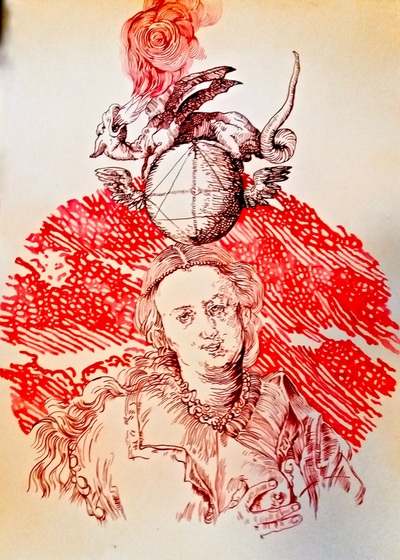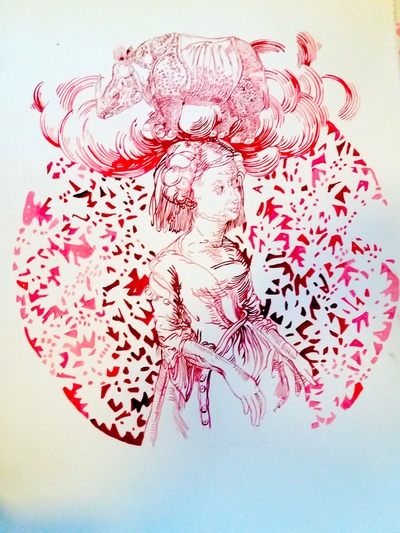Infinite Complexity Thy Name is Woman
D’ARTE Gallery, New York
548 W 28 St, Suite 328, New York, NY 10001
27 Sept - 15 Oct 2016
Installation Views
The Works
Press ReleaseGallery d’Arte, 548 West 28th Street, Suite 328, New York City proudly presents Elli Chrysidou: Infinite Complexity Thy Name is Woman an exhibition comprised of an installation series of double portraits. The show, co-curated by Thalia Vrachopoulos and Suechung Koh, will run from September 27th through October 15th, 2016 with an Opening Reception on Thursday, September 29th from 6-8PM.
Chrysidou is a conceptual artist who works in multiple media to produce installations that accord with the gallery space. In her series Dualisms she refers to multiple dualisms, or to the complexity of female, thus, she has painted the subject of caprice and multi-dimensionality in pairs of drawings that must be viewed together. So that, Dualism #58 of a woman with a globe and a fire breathing dragon above her head is paired with Dualism # 33, of the same female with an antlered deer as attribute. Chrysidou was formally educated at the University of Fine Arts, Nancy after which she taught art at the University of St. Etienne, from 1990-2007. Consequently, her work is informed by the arts of this European region but also by the German Renaissance. Because of her admiration for Durer, Chrysidou’s often horned and spiny creatures as seen in the dragon motif, can be seen as having been informed by the contents of Durer’s cabinet of curiosities and his interest in Lusterweibchen a type of horned antler chandelier sculpture that he produced with the dragon motif. Chrysidou is painting about woman’s changeability or flexibility, so that if we were to read the qualities attributed to the type of animal that accompanies each of her works, we could perhaps have more insight into the personalities, albeit stereotypical. She means for this aspect to be viewed more as a psychological complexity inherent in both genders but seen in the female of this series. |
For More Information:
Gallery d’Arte, 548 West 28th Street, Suite 328, New York, NY 10001 [email protected], [email protected] or call 201.724.7077 Gallery Hours: Tues-Fri: 12-6pm, Sat: 12-3pm, Sun & Mon: Closed |
Elli Chrysidou: Infinite Complexity Thy Name is WomanChrysidou is a conceptual artist who works in multiple media to produce installations that accord with the gallery space. In her series Dualisms she refers to multiple dualisms, or to the complexity of female, thus, she has painted the subject of caprice and multi-dimensionality in pairs of drawings that must be viewed together. So that, Dualism #58 of a woman with a globe and fire breathing dragon above her head is paired with Dualism # 33, of the same female with an antlered deer as attribute.
Chrysidou’s women drawn through line in sanguine acrylic, are each represented with animal attributes such as the dragon as seen in Dualism # 07 (Acrylic on Paper, 100x70cm). She has located the main figure to the right of the page, and has imbued it with the dual female and male gender characteristics splitting it in the middle. On the left part is a partially dressed woman with long hair, while the male on the right sports a beard, hat and doublet. Above this split representation, is a dragon and in the center a large eye motif. The lower background is embellished with a landscape that recalls those of Durer, another artist fond of using line. Chrysidou was formally educated at the University of Fine Arts, Nancy after which she taught art at the University of St. Etienne, from 1990-2007. Consequently, her work is informed by the arts of this European region but also by the German Renaissance. Chrysidou draws animals above her character’s heads that can be associated with zodiac signs or attributes. But, she often uses the dragon that in Dualism # 07 appears to the left while a fantastical horned animal is seen on the right side over the head of her split personality. Because of her admiration for Durer, Chrysidou’s often horned and spiny creatures can be seen as having been informed by the contents of Durer’s cabinet of curiosities that contained animal horns, corals, fish fins, and other animal parts. Durer was also partial to Lusterweibchen a type of horned antler chandelier sculpture and produced such a piece with the dragon motif. Chrysidou is painting about woman’s changeability or flexibility, so that if we were to read the qualities attributed to the type of animal that accompanies each of her works, we could perhaps have more insight into the personalities, albeit stereotypical. Like the dual personality shown here, the dragon also has different meanings depending on the geographic locale. The dragon in western medieval religion is associated with Satan and is traditionally depicted with St. George attacking it with a lance. However, Asians consider the dragon as a lucky and powerful symbol representing power and royalty. The eye motif placed above their heads is typically depicted in Christian religious paintings above the Christ figure symbolizing God’s watchful presence. And in ancient Egyptian iconography it is known as the eye of the powerful God Horus. Chrysidou, through this image, seems to be commenting on the dual aspects of a human that at conception receives both pairs of chromosomes. But, she means this aspect to be viewed more as a psychological complexity inherent in both genders but seen in the female of this series. |
Text by:
|
Elli Chrysidou at Gallery d’ArteElli Chrysidou is a artist born in Greece but who spent many years studying and teaching in France. Her work reflects this experience; there is an openness and breadth to her work that reflects a full-blown interest in European culture. Her recent show at Gallery d’Arte in Chelsea was composed of examples taken from the “Complexity” series, a group of drawings that addresses the status and identity of women, often through the lens of Dürer’s art. Thus, she is using the past to address contemporary issues, although there is nothing in the drawings that would indicate a specific interest in feminism or gender. Taking what can nearly be called a scholarly approach, Chrysidou shows us how women were represented in a different time in order to comment on how they are viewed now. The comparison is meant to throw light on the place of women during the Northern Renaissance and the current situation in Western art, in which women have been profoundly politicized in regard to their status in art.
Despite the current climate of contention, we know that Chrysidou makes her points with a subtlety refined enough to be out of fashion—at least in America, where we tend to confront particular populations (mostly white men) with gender issues. But there is beauty to Chrysidou’s approach, so that her work quietly communicates a vital interest with social change—with implied as opposed to explicit contention. The “Complexity” drawings are all hand painted, even the images taken from Dürer, which in Chrysidou’s hands seem incredibly true to the German originals. In one drawing, a famous female image painted by Dürer is imitated by the Chrysidou. The woman balances a sphere on her head with winds on either side. On top of the sphere is a black-and-white dragon exhaling fiery red smoke. The image, like many in the series, is apocalyptic, giving the audience the sense that something portentous is about to happen. This feeling also occurs in a drawing of an outsized eye, which stares back at the viewer. Several monsters occur beneath the dragon eye, which also looks over a figure divided in half—one side is male and the other side is female. The diversity and placement of the images are a bit difficult to register, adding to the general sense that all is not quite right. It is a surrealist image with real implications, likely describing the complicated relations between the sexes, as well as the gaze women must submit to. This complexity is memorable in the sense that it is historically based in Western painting tradition. By quoting Dürer, Chrysidou sites her art within a particularly Western tradition—one that is of course male. Yet the images are almost always of women. Contrasting the female gender with what amounts to a patriarchal tradition enables the artist to comment, more or less objectively, on the presence of the female in art over time. The persistence of the female image amounts to a declaration of importance and meaningfulness of gender. What is remarkable is that Chrysidou has found a way of asserting the female presence through a historically oriented imagery. One must not underestimate the intelligence of the approach, which is feminist by implication rather than confrontational by design. As a method, it is particularly subtle in its advance of the female gender. The danger is that the assertion of female presence may be so very subtle and indirect as to be lost lost on Chrysidou’s audience. But the point does remain. A third drawing image is that of a Dürer woman who is placed in semi-profile, looking across to the right of the composition. On her head rests a rhinoceros, standing in the midst of billowing clouds. A tondo-shaped background of leaf imagery frames the woman, but we are confused at first by the thematic relationship between her and the rhinoceros. Is the animal a figment of her imagination? Does it stand as an emblem of the pressing weight on women’s existence? Just to what extent are we meant to read the image symbolically is hard to determine. But the point is that the quotation carries a message: the persistence of the female cannot be denied, despite the hardships placed in front of her. Chrysidou suggests a heroine-like presence in these “Complexity” drawings, which elaborate the feminine in intricate, indirect ways. But it doesn’t matter if the theme is slightly oblique; instead, the intricacy refers to the position of women in life today. Chrysidou has brilliantly reconstructed the past so as to comment on the present. This results in a profundity not easily found in contemporary art. |
Text by:
|



















